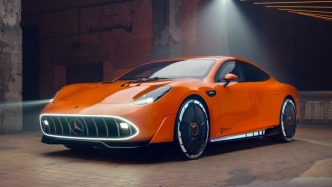
On June 26, the Mercedes-AMG GT XX made its global debut.
At first glance, it's just another eye-catching future car. Active aerodynamic wheels with movable blades between the spokes, which close at high speeds to reduce wind resistance and open when necessary to cool the brakes; the luminous paint on the side skirts; the customizable light panel between the taillights, etc.
However, it is not just a concept car. Under the bright orange body, there is another world. The birth of the AMG GT XX concept car heralds the landing of the AMG.EA platform - a new aluminum body electrification architecture that will support the next generation of Mercedes-AMG electric supercars. The first four-door "coupe" model based on this platform (similar to the AMG GT XX) is expected to be launched within a year, and Mercedes-Benz has confirmed that it will also launch an SUV on the same platform in 2027. And these are just the beginning of the AMG.EA platform product line.
When previewing the AMG GT XX concept car in Germany last month, Michael Schiebe, chairman of the AMG management board, said in an interview with the media: "We are very confident that this platform will lead to more models. Because our architecture is very flexible, not only the motor is highly adaptable, but also the battery layout is compatible with different body styles."
The production version of the AMG GT XX will be a performance beast: with three axial flux motors developed by Mercedes-Benz's Yasa company, this concept car will output more than 1000kW of power and a top speed of more than 360km/h. Its power core is a lightweight high-performance battery pack, which was developed by F1 experts from Mercedes-AMG High Performance Powertrain Co., Ltd. (HPP) based on their experience in F1 racing.
The core of the axial flux motor is a disc-shaped stator, rather than the tubular stator of the radial flux motor used in most electric vehicles. This design allows the magnetic flux to flow parallel to the motor shaft, greatly improving efficiency. Yasa CEO Jörg Miska said that the axial flux motor is 67% lighter and 67% smaller than similar radial motors, with three times the power density and twice the torque density.
The two rear motors are integrated into a single electric drive unit (EDU), which has a built-in planetary gearbox, silicon carbide inverter, oil cooling system for the motor gearbox and water cooling system for the inverter. Miska said that this rear-drive EDU weighs only 140kg, but can output more than 640kW of power. The front axle EDU contains a single axial flux motor, a spur gear gearbox and a single silicon carbide inverter, which only intervenes when additional power or traction is needed (such as acceleration or energy recovery). When driving at a constant speed, low load or coasting, the front motor is separated from the axle to reduce friction losses and improve efficiency.
These motors have been put into production at the Marienfeld plant in Berlin. The manufacturing process requires about 100 steps, 65 of which are used for the first time by Mercedes-Benz and 35 of which are world-first technologies, involving new laser processes, innovative connection technologies and artificial intelligence systems.
The power battery pack contains more than 3,000 cells, using nickel-cobalt-manganese-aluminum (NCMA) positive electrodes and silicon-containing negative electrodes. The innovative slender cylindrical design, combined with the laser-welded aluminum cell housing, allows the heat of the cells to be released faster during extreme speeds. The intelligent direct cooling system provides independent cooling for each cell through high-tech coolants, ensuring that the battery temperature is always in the optimal working window.
The battery's cooling system and over 800V high-voltage architecture enable it to accept over 850kW of charging power over a wide range. Mercedes-Benz is working with Alpitronic, a leading European high-power charging technology company, to develop a prototype ultra-fast charging pile that will allow the production version of the AMG GT XX to replenish 400km of range in 5 minutes (WLTP standard).
With its powerful power and four-wheel drive, it may not be difficult for the AMG GT XX production version to accelerate from 0 to 100 km/h in less than 3 seconds. But Michael Schebe emphasized that its real uniqueness lies in its ability to output extreme performance for a longer period of time - he hinted that the production car can complete at least three laps of full throttle sprint on the Nürburgring Nordschleife. Although three laps are only about 65 kilometers, he pointed out that most fuel performance cars will not be able to do it after running three laps. "People mistakenly believe that fuel performance cars can run endlessly on the track. In fact, after running three laps of the Nordschleife, they need to pit, either because the tires are scrapped or the fuel is exhausted."
The AMG GT XX concept car has an intriguing detail: the VIN number is printed on the lower left corner of the front windshield (it is said to be the third prototype of this type), and it is equipped with fully functional wipers - most car companies will not bother with such details on concept cars. This shows that this is a real prototype. Xie Bei confirmed: "This is a wonderful preview of the design of a mass-produced car."
Although the AMG head did not elaborate on the details, it was revealed that the roof line of the mass-produced car will be slightly higher, but still 5 cm lower than the current AMG GT four-door coupe, and the mass-produced version will adopt a hatchback design with a rear window. The front and rear bumper shapes will be adjusted, but the iconic concave straight waterfall grille and six-round taillight design will be retained. The concept car claims a drag coefficient as low as 0.198Cd. Whether the mass-produced version can reach this value is not yet known, but it is confirmed that an optional active rear diffuser (similar to the Mercedes-Benz EQ XX concept car) will be provided, which can be extended to further reduce wind resistance.
The production car will be equipped with 21-inch wheels, with 275/35 ZR21 and 315/35 ZR21 tires at the front and rear to cope with the huge power and torque transmitted through the rear axle.
Inside the car, the luxurious cockpit with a strong fighting spirit restores the pure driving atmosphere. The carbon fiber bucket seats use 3D printed cushions, covered with LABFIBER biotech leather material developed and applied for the first time in the industry. The material is made of recycled tires from GT3 racing cars and biotech materials, and has the characteristics of lightweight, breathable, waterproof and durable, exploring the application of sustainable materials in luxury cars.
The center console, door armrests and other locations adopt an exposed white body structure design, and are decorated with orange light tubes symbolizing high voltage electricity. The design of the instrument panel is derived from the engine cylinder that symbolizes the soul of AMG, and the surface is embossed with the AMG badge. The racing style steering wheel is in the same vein as the AMG ONE, with paddles that can adjust the energy recovery level and an AMG control unit.
The most surprising thing is the sound design of the mass-produced version. The GT XX concept car simulates the shocking V8 sound through the car audio system (including external speakers behind the headlights), and the sound effect is adjusted in real time according to the throttle opening and wheel speed. Xie Bei revealed that during the executive test drive a few days before the AMG GT XX preview, a board member exclaimed: "This is the best V8 we have ever developed!" Of course, this statement is somewhat exaggerated, but Mercedes-AMG's supercar-level electric four-door coupe is worth looking forward to.


